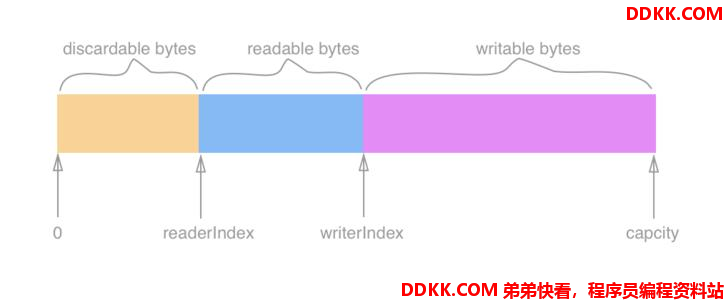一、基本介绍
1、Netty 提供一个专门用来操作缓冲区(即Netty的数据容器)的工具类
2、常用方法:
- public static ByteBuf copiedBuffer(CharSequence string, Charset charset):通过给定的数据和字符编码返回一个ByteBuf对象(类似于NIO中的ByteBuffer,但有区别)
3、Unpooled 获取Netty的数据容器ByteBuf

public class NettyByteBuf01 {
public static void main(String[] args) {
// 创建一个ByteBuf
// 说明:
// 1. 创建对象,该对象包含一个数组 arr,是一个byte[10]
// 2. 在 netty 的 buffer 中,不需要使用 flip 进行反转
// 底层维护了 readerIndex 和 writerIndex
// 3、通过 readerIndex、writerIndex 和 capacity,将buffer分成三个区域
// 0-----readerIndex:已经读取的区域
// readerIndex----writerIndex:可读的区域
// writerIndex----capacity:可写的区域
ByteBuf buffer = Unpooled.buffer(10);
for(int i=0; i < 10; i++){
buffer.writeByte(i);
}
System.out.println("capacity=" + buffer.capacity());
// 输出
for(int i=0; i < buffer.capacity(); i++){
System.out.println(buffer.getByte(i));
}
for(int i=0; i < buffer.capacity(); i++){
System.out.println(buffer.readByte());
}
System.out.println("执行完毕");
}
}
public class NettyByteBuf02 {
public static void main(String[] args) {
// 创建ByteBuf
ByteBuf byteBuf = Unpooled.copiedBuffer("Hello,World!", CharsetUtil.UTF_8);
// 使用相关的方法
if(byteBuf.hasArray()){ // true
byte[] content = byteBuf.array();
// 将 content 转成字符串
System.out.println(new String(content,CharsetUtil.UTF_8));
System.out.println("byteBuf = " + byteBuf);
System.out.println(byteBuf.arrayOffset()); // 0
System.out.println(byteBuf.readerIndex()); // 0
System.out.println(byteBuf.writerIndex()); // 12
System.out.println(byteBuf.capacity());
System.out.println(byteBuf.readByte()); // 减少一个
int len = byteBuf.readableBytes(); // 可读的字节数 11
System.out.println("len="+len);
// 使用for取出各个字节
for(int i =0;i < len; i++){
System.out.println((char) byteBuf.getByte(i));
}
// 按照某个范围读取
System.out.println(byteBuf.getCharSequence(0,4,CharsetUtil.UTF_8));
System.out.println(byteBuf.getCharSequence(4,6,CharsetUtil.UTF_8));
}
}
}